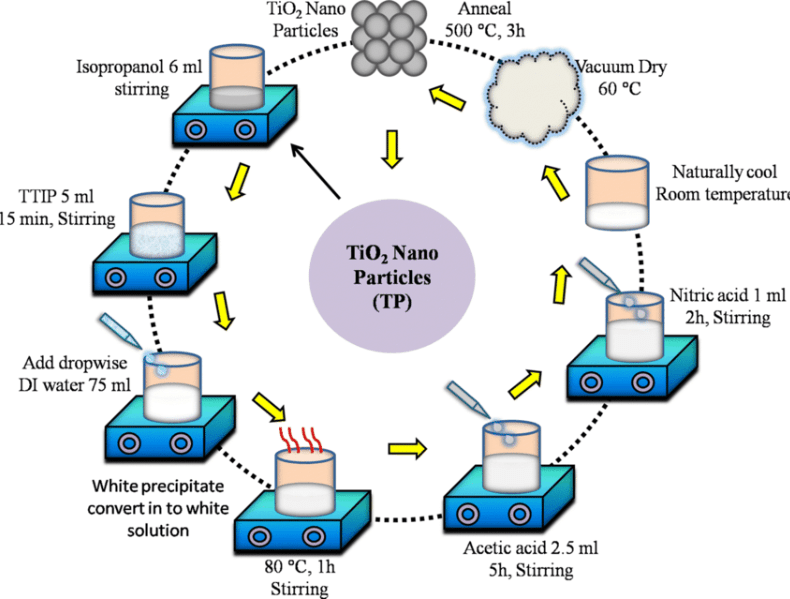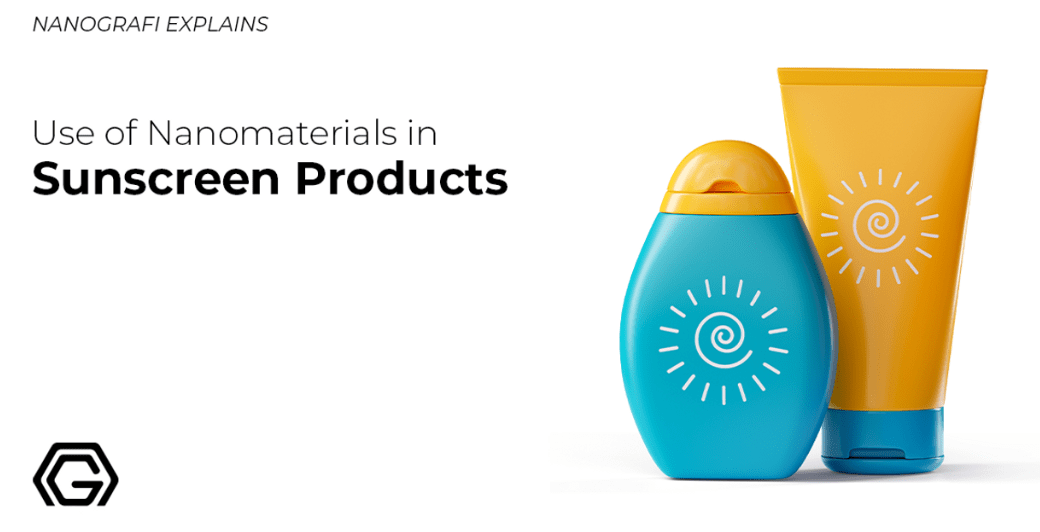Analyzed: Anatase Titanium Dioxide Nanoparticles
Ultrafine anatase titanium dioxide nanoparticles and nanocrystals (TiO2) with average particle size of less than 100nm have ultra-violate (UV) radiation blocking properties as well as the ability to prevent photocatalytic reaction if they are coated with alumina and silica.
Also, the titanium dioxide nanoparticles have applications in materials for construction purposes such as antifogging coatings and windows with self-cleaning quality. Titanium dioxide nanoparticle are referred as a safe sun blocking agent in sunscreens and UV protections creams with the least health risks compared to others. Nanoscale titanium oxide forms during a state of metastability of anatase which is the mineral of titanium dioxide since the surface energy in the anatase phase is lower than that of the equilibrium phase. Discover the company that produces nano and micro-sized products of elements from the periodic table, especially titanium dioxide. Meet Nanografi.
Introduction
Anatase Titanium Dioxide (TiO₂) nanoparticles are notable nanomaterials due to their exceptional photocatalytic properties and large surface areas. These nanoparticles exhibit high efficiency in various applications, including environmental purification, solar cells, and biomedical fields. The anatase phase of TiO₂, known for its high stability and reactivity, makes these nanoparticles particularly effective in decomposing organic pollutants and generating reactive oxygen species under UV light. Their unique crystalline structure and versatile functionality position anatase TiO₂ nanoparticles as critical components in advanced technological and industrial applications.
Overview:Titanium Dioxide (TiO2)
Titanium oxide, which is also called titania, is a naturally occurring +4 oxidation state of titanium used as a pigment known as titanium as well as in food coloring, sunscreen and paints. There are three main crystalline structures of titanium oxide namely anatase, ilmenite and rutile. It has more high-pressure titanium oxide minerals called akaogiite which is a monolithic crystal and the other one as brookite that is an orthorhombic crystalline structure. Among all, ilmenite is the most abundant on Earth crust. It constitutes nearly two-third of the available and known pigments and is regarded to play a key role in world energy generation purposes with environmental promises. Titanium dioxide is an n-type semiconductor with a broad band gap and has charge transport, surface and light absorption qualities. The cost-effective, inert and stable titanium dioxide is known for its remarkable photostable and photoactive properties making it the focus of numerous research projects in recent years.

Figure 1. Crystalline structure Titanium Oxide.
Anatase Titanium Dioxide Nanoparticles
Anatase titanium dioxide nanoparticles are considered the most commonly synthesized and industrially more important manufactured nanoparticle since the appearance of nanoscience and nanotechnology. This is mainly because of the fact that titanium dioxide nanoparticles are highly potential to contribute new functionalities to materials and compounds causing properties like self-cleanliness pollution removal quality through photocatalytic behavior activated by UV light. Generally, the anatase and rutile forms of titanium oxide are of industrial and importance. However, the anatase is more toxic and is extensively used for many purposes. Despite the toxic nature, titanium oxide nanoparticles are employed in research projects in vivo and in vitro probably due to a lack of enough reliable data of their toxicological effects and hazardous interactions with biomolecules.
Synthesis of Anatase Titanium Dioxide Nanoparticles
With regard to versatility of chemical methods of synthesizing nanoparticles, a lot of methods have also been suggested for the synthesis of anatase titanium dioxide nanoparticles and nanostructures. Microemulsion, hydrothermal crystallization, chemical vapor deposition, sol gel and chemical precipitation are the most common methods so far among which, sol get has turned out to be one of the most efficient and successful methods to obtain anatase titanium dioxide nanoparticles. Based on this procedure, highly photocatalytic titanium dioxide nanostructures with excellent control over the morphology and porosity are synthesized. In addition, the nanoparticles synthesized this way are perfectly homogenous with the high rate of purity and are achieved at lower temperatures.
In the recent years, template assisted methods have been included in the synthesis of titanium dioxide nanoparticles and nanostructures. Accordingly, the templating method is applied more frequently at the moment in order to modify the surface of nanoscale structures and improve their properties. The modification is necessarily done to avoid any possible post nucleation and agglomeration, create active sites on them and increase the selectivity, stability and compatibility. Specifically, to synthesize TiO2 nanoparticles, titanium isoproxide is dissolved in acetic acid and deionized water. The acetic acid serves as a chelating component to prevent water from nucleophilic attack on titanium isoproxide. The solution is stirred for a couple of hours with a subsequent addition of rice straw to the solution. At the next stage, the solution is heated at 80˚C to turn to the gel and is dried at the same temperature for over ten hours. The final stage involves grinding the resulting crystals and calcinating them at 500˚C 1.
In green synthesis method, titanium oxysulfate solution extraction from a plant is employed along with a carbohydrate polymer to form a solution with respective vigorous stirring, centrifuging and drying to obtain fine crystals with the final calcination at 500˚C for 4 hours.

Figure 2. Schematic diagram of the synthesis of TiO2 nanoparticles by sol–gel method.
Anatase Titanium Dioxide Nanoparticles Applications
Anatase titanium dioxide (TiO2) nanoparticles exhibit remarkable versatility and efficacy, finding extensive applications across various fields such as photocatalysis, environmental purification, solar energy, cosmetics, and biomedical treatments.
1. Photocatalysis
Anatase titanium dioxide (TiO2) nanoparticles are highly effective photocatalysts. They are widely used in environmental purification processes, such as air and water treatment. The high surface area and excellent photocatalytic activity enable the degradation of organic pollutants and the elimination of harmful microorganisms under UV light. TiO2 nanoparticles can decompose organic pollutants and aerosols through photocatalytic reactions when mixed with cement, making them ideal for removing aromatic, ammonia, NOx, and aldehyde pollutants.
2. Self-Cleaning Surfaces
The self-cleaning properties of anatase TiO2 nanoparticles make them ideal for coatings on buildings, windows, and other surfaces. When exposed to sunlight, these coatings decompose organic matter and dirt, leading to surfaces that clean themselves with minimal maintenance. This technology is increasingly being used in infrastructural projects such as tunnels, buildings, and pavements where concrete and cement are involved.
Did you know that silica nanoparticles are also used as water and dirt repellent in clothing? Learn now.
3. Sunscreens and Cosmetics
Due to their high refractive index and UV-blocking capabilities, anatase TiO2 nanoparticles are commonly used in sunscreens and cosmetic products. They provide effective protection against harmful UV radiation while maintaining transparency and aesthetic appeal in formulations. Additionally, their biocompatibility and environmental friendliness enhance their suitability for these applications.
To learn more about the use of nanomaterials in sunscreen products, read our blog post.
4. Dye-Sensitized Solar Cells (DSSCs)
Anatase TiO2 nanoparticles are crucial components in dye-sensitized solar cells (DSSCs). Their unique electronic properties enhance the efficiency of light absorption and conversion, making them integral to the development of advanced photovoltaic devices.
5. Water Splitting Devices
In water splitting devices, anatase TiO2 nanoparticles serve as semiconductors and photocatalysts. When irradiated by ultraviolet light in the presence of a gas or liquid, they facilitate the splitting of water molecules into hydrogen and oxygen, contributing to the generation of clean energy.
6. Optical Biosensors
TiO2 nanoparticles are employed as optical biosensors due to their excellent biocompatibility and ability to interact with biological molecules. These biosensors can detect various biological analytes with high sensitivity and specificity, making them valuable tools in medical diagnostics and environmental monitoring.
7. Biological Applications
Anatase TiO2 nanoparticles have found applications in biological systems, particularly in skin cancer treatment. When activated by UV light, they exhibit high efficiency in targeting and destroying cancer cells. Additionally, complex TiO2 nanoparticles combined with doxorubicin, a cancer drug, improve the drug's quality and efficacy.
Safety Information about TiO2 Nanoparticles
It has been for so long that TiO2 is referred as the “environmental white knight” mostly because of the fact that it is inert in nature; its toxicity is restricted and that it biocompatible unless its concentration exceeds the healthy dose. TiO2 has been classified as a food additive since 1996 by the Food and Drug Administration (FDA) of the United States of America. According to FDA, 50µg per kilogram of human body weight a day is the healthy dose of titanium oxide nanoparticles. In addition to this, the Joint Expert Committee on Food Additives of the Food and Agriculture Organization/World Health Organization (JECFA), the European Food Safety Authority (EFSA)’s Scientific Panel on Food Additives, Flavorings, Processing Aids and Materials in Contact with Food have and the European Commission’s Scientific Committee on Food (SCF) have jointly and officially confirmed that the healthy dose intake in a day is safe 3.
Anatase titanium dioxide nanoparticles are the mostly studied and synthesized nanostructures with wide applications in biological systems for cancer treatment in science in photocatalytic reactions, sun blocking creams (sunscreens) and in industry due to their versatility to functionalized to adopt selectivity, purity and homogeneity. Titanium dioxide nanoparticles can also be obtained based on the green chemistry promises with environmentally friendly properties.
Conclusion
Anatase titanium dioxide (TiO₂) nanoparticles are highly versatile and widely used in various industries. Their exceptional photocatalytic properties make them effective for environmental purification and self-cleaning surfaces. In cosmetics, they serve as safe UV-blocking agents in sunscreens. They are crucial in dye-sensitized solar cells and water-splitting devices for clean energy production. Additionally, they are used in optical biosensors and cancer treatments.
These nanoparticles are synthesized through efficient methods like sol-gel and template-assisted techniques, ensuring high purity and homogeneity. While generally safe, ongoing research is needed to fully understand and manage any health risks. Anatase TiO₂ nanoparticles are indispensable in advancing technology and industry.
To follow the latest developments and innovations related to nanotechnology, visit Blografi.
References
Analyzed: Titanium Oxide - Nanografi Nano Technology. (n.d.). Retrieved June 24, 2024, from https://nanografi.com/blog/analyzed-titanium-oxide-/
Constantinides, G. Nanoscience and nanoengineering of cement-based materials. Nanotechnol. Eco-Efficient Constr. 9-37a (2013). doi:10.1533/9780857098832.1.7
Ramimoghadam, D., Bagheri, S. & Abd Hamid, S. B. Biotemplated synthesis of anatase titanium dioxide nanoparticles via lignocellulosic waste material. Biomed Res. Int. 2014, (2014).
Rutile and Anatase TiO2 Nanoparticles and Applications - Nanografi Nano Technology. (n.d.). Retrieved June 24, 2024, from https://nanografi.com/blog/differences-between-rutile-and-anatase-tio2-nanoparticles-and-their-applications/
Salahuddin, N. & Galal, A. Improving chemotherapy drug delivery by nanoprecision tools. Nanostructures for Cancer Therapy (Elsevier Inc., 2017). doi:10.1016/B978-0-323-46144-3.00004-0
Saranya, S. K. S. K. S. et al. Green synthesis of high temperature stable anatase titanium dioxide nanoparticles using gum kondagogu: Characterization and solar driven photocatalytic degradation of organic dye. Nanomaterials 8, (2018).
Schematic diagram of the synthesis of TiO2 nanoparticles by sol–gel method | Download Scientific Diagram. (n.d.). Retrieved June 24, 2024, from https://www.researchgate.net/figure/Schematic-diagram-of-the-synthesis-of-TiO2-nanoparticles-by-sol-gel-method_fig1_335506698
Shah, S. N. A., Shah, Z., Hussain, M. & Khan, M. Hazardous Effects of Titanium Dioxide Nanoparticles in Ecosystem. Bioinorg. Chem. Appl. 2017, (2017).
Solved 2. “Pure” titanium dioxide is mined from the earth as | Chegg.com. (n.d.). Retrieved June 24, 2024, from https://www.chegg.com/homework-help/questions-and-answers/2-pure-titanium-dioxide-mined-earth-various-crystalline-conformations-rutile-tetragonal-b--q96842010
Titanium Oxide Nanopowder/Nanoparticles Specifications - Nanografi Nano Technology. (n.d.). Retrieved June 24, 2024, from https://nanografi.com/blog/titanium-oxide-nanopowdernanoparticles-specifications/
Use of Nanomaterials in Sunscreen Products - Nanografi Nano Technology. (n.d.). Retrieved June 24, 2024, from https://nanografi.com/blog/use-of-nanomaterials-in-sunscreen-products-/
Use of Silica Nanoparticles as Water and Dirt Repellent in Clothing - Nanografi Nano Technology. (n.d.). Retrieved June 24, 2024, from https://nanografi.com/blog/use-of-silica-nanoparticles-as-water-and-dirt-repellent-in-clothing/
Using Nanoparticles for Cancer Treatments - Nanografi Nano Technology. (n.d.). Retrieved June 24, 2024, from https://nanografi.com/blog/using-nanoparticles-for-cancer-treatments/
Recent Posts
-
The Science Behind Super Suits: Advanced Nanomaterials, CNT Fibers and Graphene Composites
From Fiction to Advanced Nanomaterials in Real Protective Systems For years, popular culture has por …4th Dec 2025 -
Beyond Reduced Graphene Oxide: Discover Nanografi’s Advanced rGO-TEPA
As research in advanced materials expands, graphene derivatives with engineered surface chemistry a …17th Nov 2025 -
High-Tech Meets High Fashion: Conductive Inks for Smart Textiles
Fashion has always been an expression of identity, but now it has become a medium of interaction. To …7th Nov 2025






